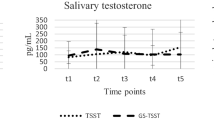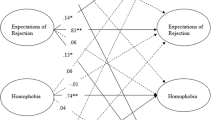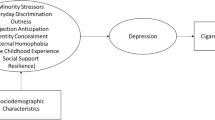Abstract
Gay men experience various stressors, including gay-specific stressors such as discrimination and internalized homonegativity as well as general stressors such as occupational and financial strain. While a robust literature has examined how gay-specific stressors are associated with negative mental health outcomes among gay men, less attention has been paid to the association between general stress and gay men’s psychological functioning or to how different types of stressors may interact to affect functioning. The current study sought to address this gap by examining the unique and combined associations between gay-specific external stress (discrimination), gay-specific internal stress (rejection sensitivity, internalized homonegativity, sexual identity concealment), and general stressors (e.g., academic difficulties) and negative affect and alcohol use over time. A total of 147 self-identified gay men living in the greater New York City area participated in a baseline assessment and a 7-week diary study. Univariate and multivariate results revealed that gay-specific external stress, gay-specific internal stress, and general stress were each positively and uniquely associated with higher mean levels of and greater fluctuations in negative affect over time, and general stress was positively associated with greater fluctuations in alcohol use over time. Multiplicative analyses indicated that individuals reporting high levels of stress in multiple domains experienced particularly high mean levels of negative affect. These findings highlight the unique contribution of general stress to gay men’s functioning over time and underscore the importance of considering multiple forms of stress (i.e., gay-specific and general stress) and their interactions to better understand gay men’s psychological functioning.

Similar content being viewed by others
References
Baams, L., Grossman, A. H., & Russell, S. T. (2015). Minority stress and mechanisms of risk for depression and suicidal ideation among lesbian, gay, and bisexual youth. Developmental Psychology,51, 688–696.
Balsam, K. F., Lehavot, K., & Beadnell, B. (2011). Sexual revictimization and mental health: A comparison of lesbians, gay men, and heterosexual women. Journal of Interpersonal Violence,26, 1798–1814.
Bartholow, B. D., & Heinz, A. (2006). Alcohol and aggression without consumption: Alcohol cues, aggressive thoughts, and hostile perception bias. Psychological Science,17, 30–37.
Beiter, R., Nash, R., McCrady, M., Rhoades, D., Linscomb, M., Clarahan, M., & Sammut, S. (2015). The prevalence and correlates of depression, anxiety, and stress in a sample of college students. Journal of Affective Disorders,173, 90–96.
Birkett, M., Newcomb, M. E., & Mustanski, B. (2015). Does it get better? A longitudinal analysis of psychological distress and victimization in lesbian, gay, bisexual, transgender, and questioning youth. Journal of Adolescent Health,56, 280–285.
Bostwick, W. B., Boyd, C. J., Hughes, T. L., & McCabe, S. E. (2010). Dimensions of sexual orientation and the prevalence of mood and anxiety disorders in the United States. American Journal of Public Health,100, 468–475.
Brown, T. A., Chorpita, B. F., & Barlow, D. H. (1998). Structural relationships among dimensions of the DSM-IV anxiety and mood disorders and dimensions of negative affect, positive affect, and autonomic arousal. Journal of Abnormal Psychology,107, 179–192.
Cain, D. N., Mirzayi, C., Rendina, H. J., Ventuneac, A., Grov, C., & Parsons, J. T. (2017). Mediating effects of social support and internalized homonegativity on the association between population density and mental health among gay and bisexual men. LGBT Health,4, 352–359.
Cox, N., Berghe, W. V., Dewaele, A., & Vinke, J. (2008). General and minority stress in an LGB population in Flanders. Journal of LGBT Health Research,4, 181–194.
Dyar, C., Feinstein, B. A., Eaton, N., & London, B. (2016). Development and initial validation of the Sexual Minority Women Rejection Sensitivity Scale. Psychology of Women Quarterly,40, 120–137.
Eaton, L. G., & Funder, D. C. (2001). Emotional experience in daily life: Valence, variability, and rate of change. Emotion,1, 413–421.
Eaton, N. R., Krueger, R. F., Markon, K. E., Keyes, K. M., Skodol, A. E., Wall, M., & Grant, B. F. (2013). The structure and predictive validity of the internalizing disorders. Journal of Abnormal Psychology,122, 86–92.
Eldesouky, L., Thompson, R. J., Oltmanns, T. F., & English, T. (2018). Affective instability predicts the course of depression in late middle-age and older adulthood. Journal of Affective Disorders,239, 72–78.
Faul, F., Erdfelder, E., Lang, A. G., & Buchner, A. (2007). G* Power 3: A flexible statistical power analysis program for the social, behavioral, and biomedical sciences. Behavior Research Methods,39, 175–191.
Feinstein, B. A. (2019). The rejection sensitivity model as a framework for understanding sexual minority mental health. Archives of Sexual Behavior. https://doi.org/10.1007/s10508-019-1428-3.
Feinstein, B. A., & Dyar, C. (2017). Bisexuality, minority stress, and health. Current Sexual Health Reports,9, 42–49.
Feinstein, B. A., McConnell, E., Dyar, C., Mustanski, B., & Newcomb, M. E. (2019). The influence of stress on depression and substance use problems among young male same-sex couples: Relationship functioning as an underlying mechanism. Clinical Psychological Science,7, 928–940.
Fingerhut, A. W., Peplau, L. A., & Gable, S. L. (2010). Identity, minority stress and psychological well-being among gay men and lesbians. Psychology & Sexuality,1, 101–114.
Goldbach, J. T., Tanner-Smith, E. E., Bagwell, M., & Dunlap, S. (2014). Minority stress and substance use in sexual minority adolescents: A meta-analysis. Prevention Science,15, 350–363.
Gottfredson, N. C., & Hussong, A. M. (2013). Drinking to dampen affect variability: Findings from a college student sample. Journal of Studies on Alcohol and Drugs,74, 576–583.
Green, K. E., & Feinstein, B. A. (2012). Substance use in lesbian, gay, and bisexual populations: an update on empirical research and implications for treatment. Psychology of Addictive Behaviors,26, 265–278.
Greenfield, T. K. (2000). Ways of measuring drinking patterns and the difference they make: experience with graduated frequencies. Journal of Substance Abuse,12, 33–49.
Hammen, C. (2005). Stress and depression. Annual Review of Clinical Psychology,1, 293–319.
Hatzenbuehler, M. L. (2009). How does sexual minority stigma “get under the skin”? A psychological mediation framework. Psychological Bulletin,135, 707–730.
Hatzenbuehler, M. L., McLaughlin, K. A., & Nolen-Hoeksema, S. (2008). Emotion regulation and internalizing symptoms in a longitudinal study of sexual minority and heterosexual adolescents. Journal of Child Psychology and Psychiatry,49, 1270–1278.
Hawkins, J. D., Catalano, R. F., & Miller, J. Y. (1992). Risk and protective factors for alcohol and other drug problems in adolescence and early adulthood: Implications for substance abuse prevention. Psychological Bulletin,112, 64–105.
Hill, C. L. M., & Updegraff, J. A. (2012). Mindfulness and its relationship to emotional regulation. Emotion,12, 81–90.
Hoy-Ellis, C. P. (2016). Concealing concealment: The mediating role of internalized heterosexism in psychological distress among lesbian, gay, and bisexual older adults. Journal of Homosexuality,63, 487–506.
Hussong, A. M. (2003). Further refining the stress-coping model of alcohol involvement. Addictive Behaviors,28, 1515–1522.
Iida, M., Shrout, P. E., Laurenceau, J.-P., & Bolger, N. (2012). Using diary methods in psychological research. In H. Cooper, P. M. Camic, D. L. Long, A. T. Panter, D. Rindskopf, & K. J. Sher (Eds.), APA handbook of research methods in psychology, Vol. 1: Foundations, planning, measures, and psychometrics (pp. 277–305). Washington, DC: American Psychological Association.
Johnson, J. H., & Sarason, I. G. (1978). Life stress, depression and anxiety: Internal-external control as a moderator variable. Journal of Psychosomatic Research,22, 205–208.
Lazarus, R. S., & Folkman, S. (1984). Stress, appraisal, and coping. New York: Springer.
Leary, M. R., Tambor, E. S., Terdal, S. K., & Downs, D. L. (1995). Self-esteem as an interpersonal monitor: The sociometer hypothesis. Journal of Personality and Social Psychology,68, 518–530.
Lewis, R. J., Derlega, V. J., Griffin, J. L., & Krowinski, A. C. (2003). Stressors for gay men and lesbians: Life stress, gay-related stress, stigma consciousness, and depressive symptoms. Journal of Social and Clinical Psychology,22, 716–729.
Liu, S., Wang, M., Zhan, Y., & Shi, J. (2009). Daily work stress and alcohol use: Testing the cross-level moderation effects of neuroticism and job involvement. Personnel Psychology,62, 575–597.
Marks, G., Bingman, C. R., & Duval, T. S. (1998). Negative affect and unsafe sex in HIV-positive men. AIDS and Behavior,2, 89–99.
Marshal, M. P., Friedman, M. S., Stall, R., & Thompson, A. L. (2009). Individual trajectories of substance use in lesbian, gay and bisexual youth and heterosexual youth. Addiction,104, 974–981.
McCabe, S. E., Hughes, T. L., Bostwick, W. B., West, B. T., & Boyd, C. J. (2009). Sexual orientation, substance use behaviors and substance dependence in the United States. Addiction,104, 1333–1345.
Meyer, I. H. (2003). Prejudice, social stress, and mental health in lesbian, gay, and bisexual populations: conceptual issues and research evidence. Psychological Bulletin,129, 674–697.
Mimiaga, M. J., Biello, K., Reisner, S. L., Crane, H. M., Wilson, J., Grasso, C., … Safren, S. A. (2015). Latent class profiles of internalizing and externalizing psychosocial health indicators are differentially associated with sexual transmission risk: Findings from the CFAR Network of Integrated Clinical Systems (CNICS) Cohort Study of HIV-infected men engaged in primary care in the United States. Health Psychology,34, 951–959.
Moberly, N. J., & Watkins, E. R. (2008). Ruminative self-focus, negative life events, and negative affect. Behaviour Research and Therapy,46, 1034–1039.
Mohr, J. J., & Kendra, M. S. (2011). Revision and extension of a multidimensional measure of sexual minority identity: The Lesbian, Gay, and Bisexual Identity Scale. Journal of Counseling Psychology,58, 234–245.
Moody, R. L., Starks, T. J., Grov, C., & Parsons, J. T. (2018). Internalized homophobia and drug use in a national cohort of gay and bisexual men: Examining depression, sexual anxiety, and gay community attachment as mediating factors. Archives of Sexual Behavior,47, 1133–1144.
Nagurney, A. J. (2007). The effects of relationship stress and unmitigated communion on physical and mental health outcomes. Stress and Health,23, 267–273.
Newcomb, M. E., & Mustanski, B. (2010). Internalized homophobia and internalizing mental health problems: A meta-analytic review. Clinical Psychology Review,30, 1019–1029.
Norcross, J. C., & Wampold, B. E. (2011). What works for whom: Tailoring psychotherapy to the person. Journal of Clinical Psychology,67, 127–132.
Pachankis, J. E., & Bernstein, L. B. (2012). An etiological model of anxiety in young gay men: From early stress to public self-consciousness. Psychology of Men & Masculinity,13, 107–122.
Pachankis, J. E., & Goldfried, M. R. (2006). Social anxiety in young gay men. Journal of Anxiety Disorders,20, 996–1015.
Pachankis, J. E., Goldfried, M. R., & Ramrattan, M. E. (2008). Extension of the rejection sensitivity construct to the interpersonal functioning of gay men. Journal of Consulting and Clinical Psychology,76, 306–317.
Pachankis, J. E., Hatzenbuehler, M. L., Rendina, H. J., Safren, S. A., & Parsons, J. T. (2015). LGB-affirmative cognitive-behavioral therapy for young adult gay and bisexual men: A randomized controlled trial of a transdiagnostic minority stress approach. Journal of Consulting and Clinical Psychology,83, 875–889.
Pachankis, J. E., Hatzenbuehler, M. L., & Starks, T. J. (2014). The influence of structural stigma and rejection sensitivity on young sexual minority men’s daily tobacco and alcohol use. Social Science and Medicine,103, 67–75.
Pachankis, J. E., Sullivan, T. J., Feinstein, B. A., & Newcomb, M. E. (2018). Young adult gay and bisexual men’s stigma experiences and mental health: An 8-year longitudinal study. Developmental Psychology,54, 1381–1393.
Pachankis, J. E., Westmaas, J. L., & Dougherty, L. R. (2011). The influence of sexual orientation and masculinity on young men’s tobacco smoking. Journal of Consulting and Clinical Psychology,79, 142–152.
Preacher, K. J., Curran, P. J., & Bauer, D. J. (2006). Computational tools for probing interactions in multiple linear regression, multilevel modeling, and latent curve analysis. Journal of Educational and Behavioral Statistics,31, 437–448.
Ramirez, J. L., & Paz Galupo, M. (2019). Multiple minority stress: The role of proximal and distal stress on mental health outcomes among lesbian, gay, and bisexual people of color. Journal of Gay & Lesbian Mental Health,23, 145–167.
Rotheram-Borus, M. J., Hunter, J., & Rosario, M. (1994). Suicidal behavior and gay-related stress among gay and bisexual male adolescents. Journal of Adolescent Research,9, 498–508.
Scheiderer, E. M., Wang, T., Tomko, R. L., Wood, P. K., & Trull, T. J. (2016). Negative affect instability among individuals with comorbid borderline personality disorder and posttraumatic stress disorder. Clinical Psychological Science,4, 67–81.
Schulenberg, J., O’Malley, P. M., Bachman, J. G., Wadsworth, K. N., & Johnston, L. D. (1996). Getting drunk and growing up: trajectories of frequent binge drinking during the transition to young adulthood. Journal of Studies on Alcohol,57, 289–304.
Stall, R., & Wiley, J. (1988). A comparison of alcohol and drug use patterns of homosexual and heterosexual men: The San Francisco Men’s Health Study. Drug and Alcohol Dependence,22, 63–73.
Starr, L. R., Hammen, C., Conway, C. C., Raposa, E., & Brennan, P. A. (2014). Sensitizing effect of early adversity on depressive reactions to later proximal stress: Moderation by 5-HTTLPR and CRHR1 in a 20-year longitudinal study. Development and Psychopathology,26, 1241–1254.
Sturgeon, J. A., Arewasikporn, A., Okun, M. A., Davis, M. C., Ong, A. D., & Zautra, A. J. (2016). The psychosocial context of financial stress: Implications for inflammation and psychological health. Psychosomatic Medicine,78, 134–143.
Szymanski, D. M. (2006). Does internalized heterosexism moderate the link between heterosexist events and lesbians’ psychological distress? Sex Roles,54, 227–234.
Tavakol, M., & Dennick, R. (2011). Making sense of Cronbach’s alpha. International Journal of Medical Education,2, 53–55.
Tennant, C. (2001). Work-related stress and depressive disorders. Journal of Psychosomatic Research,51, 697–704.
Trocki, K. F., & Leigh, B. C. (1991). Alcohol consumption and unsafe sex: a comparison of heterosexuals and homosexual men. Journal of Acquired Immune Deficiency Syndromes,4, 981–986.
Wallace, D. D., Boynton, M. H., & Lytle, L. A. (2017). Multilevel analysis exploring the links between stress, depression, and sleep problems among two-year college students. Journal of American College Health,65, 187–196.
Watson, D., & Clark, L. A. (1999). The PANAS-X: Manual for the positive and negative affect schedule-expanded form. Iowa City, IA: University of Iowa.
Watson, D., & Pennebaker, J. W. (1989). Health complaints, stress, and distress: Exploring the central role of negative affectivity. Psychological Review,96, 234–254.
Williamson, I. R. (2000). Internalized homophobia and health issues affecting lesbians and gay men. Health Education Research,15, 97–107.
Zeigler-Hill, V., & Abraham, J. (2006). Borderline personality features: Instability of self-esteem and affect. Journal of Social and Clinical Psychology,25, 668–687.
Funding
Data collection was supported by grants from the American Psychological Association of Graduate Students and the Society for the Psychological Study of Social Issues (PI: Brian A. Feinstein). Brian A. Feinstein’s time was supported by a grant from the National Institute on Drug Abuse (K08DA045575). The content of this article is solely the responsibility of the authors and does not represent the official views of the funding agencies.
Author information
Authors and Affiliations
Corresponding author
Ethics declarations
Conflict of interest
The authors declare that they have no conflict of interest.
Ethical Approval
All procedures performed in studies involving human participants were in accordance with the ethical standards of the institutional and/or national research committee and with the 1964 Helsinki declaration and its later amendments or comparable ethical standards.
Informed Consent
Informed consent was obtained from all individual participants included in the study.
Additional information
Publisher's Note
Springer Nature remains neutral with regard to jurisdictional claims in published maps and institutional affiliations.
Rights and permissions
About this article
Cite this article
Petruzzella, A., Feinstein, B.A., Davila, J. et al. Gay-Specific and General Stressors Predict Gay Men’s Psychological Functioning Over Time. Arch Sex Behav 49, 1755–1767 (2020). https://doi.org/10.1007/s10508-020-01672-4
Received:
Revised:
Accepted:
Published:
Issue Date:
DOI: https://doi.org/10.1007/s10508-020-01672-4




